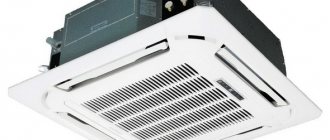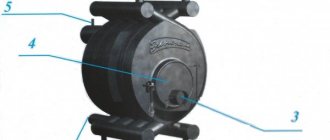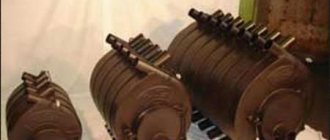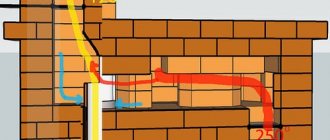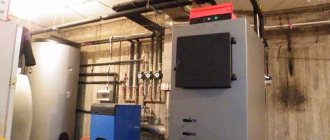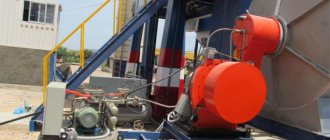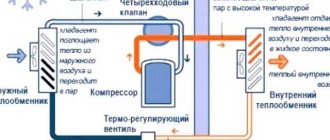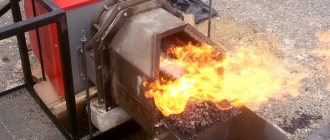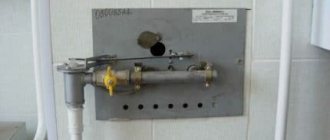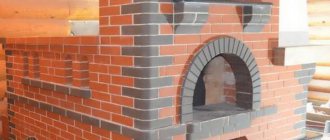Date of publication: March 06, 2020
Wood heating today is often used as the main engineering system for heating the entire house or cottage. But ordinary stoves and fireplaces are designed to heat one or more rooms. The task of heating the entire building, especially a large area, can be handled by either a boiler or a long-burning stove.
If we compare a boiler and a long-burning stove, then the second type of heaters is the most optimal. The heating boiler wastes quite a lot of energy and fuel. A long-burning stove is much more economical and efficient, plus it also has design functions, giving the user the opportunity to admire a live fire. This article will discuss the advantages, types, design and operating principle of such heating devices.
What is “long burning”?
The main feature of this type of stove is its long-term combustion of fuel - efficient and economical. This possibility is achieved due to the special design of the combustion chamber and the inclusion of modern options that allow the combustion of flue gases. In other words, long-burning appliances use not only fuel to generate thermal energy, but also exhaust gases - combustion products. Thus, the fuel burns more slowly, more efficiently - it burns, in fact, not once, but twice, consuming less fuel, while generating more thermal energy from it.
Fireplace stove for long burning
How a long-burning unit differs from a conventional stove or fireplace can be seen from its name. Unlike stoves and fireplaces of conventional design, modern long-burning home stoves and fireplaces can operate on one load of fuel (wood or pellets) for several hours.
Modern fireplace stoves are a good alternative to centralized heating.
Pyrolysis principle
The vast majority of models of this type use the principle of active and prolonged afterburning of pyrolysis gases. Pyrolysis is the process of decomposition of firewood under high temperature conditions. An important condition for pyrolysis is the almost total absence of air in the combustion chamber. A severe lack of air in the firebox forces the fuel not to burn, but to smolder: during this process, pyrolysis gas is formed, which, in turn, is sent to the secondary afterburning chamber. A small amount of oxygen is supplied here for secondary combustion, which ignites the pyrolysis gas to create a second “portion” of heat. It is important to note that the combustion of gases causes a much higher thermal output than even the wood itself. This is why long-burning stoves are considered so effective.
Design features
The features of such a stove include its entire design, which includes:
- Casing made of metal.
- Two combustion chambers, sealed from each other and from the casing.
- Dampers with which you can regulate the air supply to the combustion zone.
The operating principle of this furnace is as follows:
- The firewood placed in the firebox is set on fire and the dampers are opened completely. That is, the stove works like a regular potbelly stove.
- As soon as the temperature inside the chamber has reached +200°C, the dampers are closed. That is, the supply of fresh air is reduced.
- Now you need to adjust the dampers so that the wood in the firebox does not burn with a “blue flame”. They must, as mentioned above, smolder.
- In the design of a long-burning stove for a summer residence, the casing is separated from the fireboxes by an air jacket. That is, there is a gap between the two walls. Heat is transferred to the room through the air inside the unit. This partially reduces the efficiency, but increases the service life of the heating device itself.
Long-burning wood stove
Although it should be noted that double walls are not a mandatory design condition. So it is possible to make such a unit without an air gap. But in any case, such stoves provide high heat transfer and minimal fuel consumption. It should be noted that you can buy stoves on the market, the firewood in which will smolder for up to two days. And it is noted that the dimensions of the installation are quite small.
There is one very interesting point in this whole situation. If oxygen is supplied to the firebox in inappropriate quantities, condensation will begin to form on the walls of the device and in the chimney. If the oxygen supply is increased, soot will form in large quantities. So this is a double-edged sword. Therefore, precise adjustment of the dampers is necessary. This is the whole point of the technology of firing a stove for long-term combustion.
Buleryan
Design flaws
We have introduced you to the advantages of this type of oven. But it has four drawbacks. True, some of them cannot be classified as disadvantages, because this is the design of the device. But still:
- It is very difficult to install a water circuit in such a stove. This is due to the fact that this model is purely convection. Although such options have appeared on the market for a long time.
- Very high requirements for the moisture content of the fuel used. Firewood must be very dry. High humidity reduces heat generation, so the oven begins to work incorrectly. In any case, don't expect high efficiency from it.
- The chimney is subject to very stringent requirements. This involves not only accurate calculation of its diameter, but also correct installation. Some models require vertical installation, some inclined or partially horizontal. Therefore, this issue will have to be sorted out in accordance with the chosen model.
- Setting up such a unit is not easy. It is better to entrust this process to a specialist. The thing is that changing some operating factors can lead to a decrease in efficiency. For example, the same dampness of firewood, changes in air circulation indoors and in the house as a whole.
The disadvantages are significant. But all this is compensated by the high heat transfer efficiency of the device, savings in fuel consumption and other positive aspects of the long-burning stove-fireplace.
Stropuva
Design and equipment of a long-burning furnace
Visually, long-burning stoves are very similar to ordinary traditional fireplaces. They just have a different configuration, hidden under the body. The design solution of such heaters consists of:
- firebox (combustion chamber) in which combustion occurs. The chamber has two parts - in one, firewood is burned, in the other, made in the shape of a dome, flue gases are stored.
- doors with glass to create maximum tightness of the firebox
- cases with decorative finishing
- regulators of combustion processes and air supply (primary, secondary)
- ash box and firewood (optional)
- chimney
The configuration described above is basic. Long-burning stoves are often supplemented with other devices that increase the heat transfer of the hearth. The most effective are such add-ons. options such as a water “hydro” circuit and a system for distributing hot air throughout the premises. In this case, the basic configuration is equipped with the following devices:
- pipes for connecting air distribution
- turbine
- convection casing
- water circuit, heat exchanger
- control system (sensors, regulators)
Furnace operation process
- Before starting work, the firebox is filled with a large volume of well-dried wood with a humidity of about 20%. A large volume of firewood is a prerequisite, since the mass of fuel will generate thermal energy for a long time. Chips are placed on top of the wood pulp and set on fire - it is important that the fuel burns from top to bottom.
- When the top wood begins to burn and the temperature in the combustion chamber reaches high levels, the supply of primary oxygen should be almost completely stopped - this is done using a special regulator included in the package. Along with a minimum supply of oxygen, the blower door and the firebox door must be open for some time - this will help heat the firewood and raise the temperature to about 300 degrees Celsius. After this, the firebox door is closed completely, and the combustion oxygen supply mode is set to a minimum, which ensures the “smoldering” mode of the fuel.
- When the wood begins to demonstrate a good level of combustion, the primary air can be shut off, and the secondary air, on the contrary, can be allowed into the firebox using a regulator. The secondary air will start the process of burning pyrolysis gases and generating a second “portion” of thermal energy.
If all recommendations are correctly followed and fuel is fully added to the combustion chamber, the stove can heat a building from six to twelve hours or more with one portion of firewood. There are also models that are capable of generating heat in long-term burning mode for up to 3 days.
Important! The number of hours of continuous heating from such a stove depends on the power and volume of the combustion chamber - the more fuel is placed in it, the longer it will take for heat transfer to occur.
Choosing a stove
When moving on to choosing a long-burning stove, you need to decide how much area it will heat. Currently, manufacturers offer models with which it will be possible to maintain the required temperature in private country houses with an area of 80-250 m². Let's face it, a very good range, which makes it possible for many suburban residents to use these heating units. This is the first one.
Boiler in the interior
The second is the duration of fuel smoldering in the first combustion chamber. Here the long-burning stove is divided into three groups:
- With a minimum time: from 5 to 8 hours.
- With average: from 8 to 10 hours.
- With a maximum: over 10 hours.
Material of manufacture
An equally important component of the choice is the material from which the stove will be made. Currently, three main materials are used: steel, cast iron and brick. And when the question arises, is it possible to make a long-burning stove with your own hands, life itself has answered for everything. No problem, it’s possible and even easy.
What to choose? If the question is about making a stove with your own hands, then you shouldn’t mess with cast iron, and it won’t work. The technology for casting the necessary components, parts and components is too complex. That leaves brick and steel.
Schematic diagram
What can you say about a brick stove? This is a traditional option that justifies itself in all cases of life. The only negative is that it will take too long to heat the room to achieve the required temperature. Brick has great inertia, so warming up the masonry even in one element will not be easy and will take a long time. And this will take a large amount of fuel.
Therefore, all that remains is a long-burning stove, which you can make yourself. For example, from a barrel. Let's look at this model, which has its own name - Bubafonya. By the way, wood burning stoves made from barrels have always been popular. They did not require large material costs, their design is simple, making it yourself is not a problem. The only thing I would like to note is the need to have skills in working with electric welding, a grinder, and measuring tools.
Advantages of long-burning stoves
Heating stoves with such capabilities are more expensive than classic stoves or even fireplaces. But their heat transfer and economical fuel consumption are worth it and will fully pay for themselves in the future. Let us list the main advantages of this type of fireplace:
- economical fuel consumption
- high level of heat transfer
- heating the whole house
- heating the house throughout the day or night without the need for additional firewood
- high level of efficiency
- almost complete absence of ash
- Possibility of connecting a water housing
- possibility of connecting a hot air distribution system
Types of long-burning wood stoves for heating houses and other buildings
Numerous manufacturers offer various options for long-burning stoves that you can buy for your home. If you do not want to use the unit for cooking, then you should think about purchasing a Finnish stove for heating your home. As an option, you can make a brick oven for your home with your own hands.
Long-burning wood burning stoves for your home or cottage
Economical in fuel consumption and decorating the interior, wood-burning stoves-fireplaces for the home last a very long time. Ignition and heating of the room take place in a short time. Some models are equipped with hobs.
It is convenient to remove ash while the fireplace is operating. But despite their interesting appearance, such devices distribute heat worse. At the top of the room it is much warmer than closer to the floor. Another disadvantage is the active formation of soot on the internal surfaces of pipes due to the condensation of very hot smoke. With such actively used fireplaces, the chimney needs to be cleaned quarterly.
Boilers
A boiler is another commonly chosen unit for heating a home, which also works by smoldering wood while restricting air access. The main advantage of boilers is that there is no need to frequently add fuel. The technical characteristics of such heating equipment depend on the model version. The next stacking of firewood can be done in a few hours. The maximum period is 12 hours. It is not necessary to burn with wood; solid fuel will also work.
Other communications do not need to be connected to the boiler. Such devices are not cheap, and the efficiency rarely exceeds 89%. Another disadvantage is the inability to adjust the temperature.
Ovens with hobs
This additional function of a long-burning stove, such as cooking, is pleasantly combined with the overall reliability of the unit. Such equipment will fit perfectly into the kitchen environment, as modern design is very diverse. Numerous models presented by manufacturers are easy to transport and install without problems. It is recommended to use only high quality firewood. Otherwise, efficiency decreases. There are some difficulties with lowering the temperature on the metal surface of some units. When choosing a model, it is better to opt for those that have an additional shutter to lower the temperature.
We save wisely: an energy-saving electric heating boiler. In a special publication on our portal, we will talk in detail about electric heating energy-saving boilers. You will learn the operating principle of energy-saving electric heating boilers, types of boilers, installation features and comparative characteristics of boilers.
Furnaces with water circuit
The hydro circuit, which is equipped with many models of stoves with the “long burning” function, is an extremely significant advantage and provides a number of amenities that significantly increase the level of comfort of those living in the house. The principle of operation of the hydraulic circuit is the circulation of the coolant - water - through the heat exchanger of the furnace, located in close proximity to the combustion chamber. Heated by fire, water flows from the stove to other functional elements and systems connected to the unit.
The following can be connected to the furnace water circuit:
- boiler
- radiators and radiators in selected rooms
- "warm floors" system
The water circuit allows you to organize the operation of not only the heating system, but also the hot water supply of the entire house. This option is extremely comfortable, especially in suburban conditions, and economical, since the user does not need to spend any additional resources to ensure the operation of the hot water system. The water circuit allows you to use fuel and a long-burning system with maximum benefit and efficiency. The generated thermal energy will be supplied to the radiators in the selected rooms, as well as to the boilers.
Important! The water circuit is almost the only way in which it is possible to organize an autonomous and independent heating and hot water supply system for the entire house, provided that stove equipment is used.
Long-burning stove with warm air distribution system
A long-burning stove can also be supplemented with a system for distributing hot air to rooms adjacent to the heater. Connection of this system is possible together with a hydraulic circuit. The air duct system allows you to direct hot air flows to those rooms that require heating. To do this, hoses are connected to the outlet pipes of the furnace - air ducts, which at their other end lead to the selected rooms. The ends of the air ducts are usually decorated with special ventilation grilles. Often the air distribution system is supplemented with special turbines, which pump hot air into the premises with greater efficiency and speed. The only thing is that this heating method is only suitable for rooms located next to the stove. It will not be possible to heat distant rooms using this method due to the impossibility of installing excessively long air ducts - the heated air will cool along the way.
Additional heat dissipation of the furnace
The oven can be supplemented not only with a water circuit and air ducts, but also with special materials that will enhance the heat transfer of the device. Such materials include soapstone, or as it is called in Europe – steatite. This natural stone has unique heat-storing properties, actively accumulating thermal energy during the combustion of fire and then smoothly releasing it in all directions of the space. Talklorite can release accumulated heat for up to two days, depending on the volume and mass of the masonry. These properties of the stone are an excellent addition to the long-burning system of the stove, increasing the heat transfer of the hearth several times at once. To enhance the thermal capabilities of the furnace, lining with soapstone chlorite can be located on the facade of the product - as a cladding, or be included in the internal parts of the device.
Types and designs of long-burning wood stoves for homes
These heating devices, unlike conventional stoves, burn fuel very slowly. The wood simply smolders, not burns. This effect is achieved by regulating the air flow. To achieve this, the design provides for complete sealing of the combustion chamber. Air is forced into it in the required quantity. In addition, a large amount of firewood is placed in the firebox, and it burns from top to bottom. All this ensures a very long combustion, which significantly saves fuel, and the efficiency of such stoves reaches 80%.
A wood-burning stove will quickly provide warmth.
There are several types of long-burning wood-burning home stoves. They all have their own design features. Depending on the types of fuel that can be used, they are divided into:
- Strictly wood-fired. (Works only on wood)
- Solid fuel. (Work on any solid fuel: wood, coal, fuel briquettes, sawdust)
- Gas-fired. (In addition to firewood, gas can be used as fuel)
- Electric wood burning. (The design includes an electric boiler)
Stove-fireplace with stove for cooking.
At the same time, you need to understand that the effect of long-term combustion is achieved only when using solid fuel.
According to the combustion method, direct-flow furnaces and gas generators can be distinguished. The first type involves obtaining energy only from the combustion of solid fuel. The second type is more complicated. In it, the combustion chamber has two sections. Firewood is loaded into one of them, and in the other, the gases released during the combustion of firewood are burned out. This design is more efficient, economical and has greater efficiency.
Wood burning stove with oven and hob.
According to their design, furnaces can be:
- ordinary;
- with a stove for cooking;
- with oven;
- stoves-fireplaces.
According to the method of heat transfer, furnaces are divided into:
- convection - cold air is taken from the floor, passes along the heated walls of the combustion chamber and, hot, exits at the top of the housing directly into the atmosphere, heating it;
Sectional view of a convection wood-burning oven.
- with a liquid heat exchanger - a heat exchanger is installed in the combustion chamber or on a pipe, to which a liquid heating system installed throughout the house is connected.
In addition, stoves differ in power and purpose.
On a note! For maximum effect, it is necessary to place well-dried large firewood or special briquettes into the stove. This will increase the burning duration and allow more heat to be released per unit volume of firewood.
To get maximum heat transfer, use dry firewood.
Long-burning stoves on the Russian market
A large assortment of stoves with long-burning options from the world's leading manufacturers is presented in all showrooms. In the showrooms, customers will find products of various sizes, designs, arrangement methods, and power. Models are presented with a hydraulic circuit and pipes for distributing hot air to adjacent rooms. We also sell individual components, heat-storing stones and materials, and services for creating individual projects for heating houses of any size.
